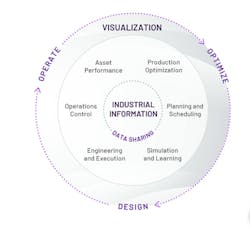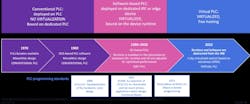How Digital Transformation, Virtualization and Software-Defined Automation are Reshaping Industrial Operations
Change is happening at record speed. More technologies are arriving, while many more are quickly becoming obsolete. For manufacturers that rely on systems designed and installed decades ago, this is particularly impactful. Today for example, industrial digital transformation is progressing at pace. It is fundamentally transforming the industrial “design, optimize, operate” cycle, improving hand-offs, maximizing efficiency and minimizing errors.
The consequential need to merge data and the flow of digital information with the operation of physical processes and machinery is also forcing convergence between IT and OT domains. This results in a sharing of cultures, expectations and engineering techniques such as virtualization, object-based programming and the ability to select a hardware platform based solely on application performance requirements.
Recent developments in software-defined automation (SDA) have rapidly transformed the traditional industrial automation model. This new approach, brought along with industrial digitalization, allows devices and equipment to be freely connected across architecture layers regardless of manufacturer. Hardware and software can be selected independently of each other, and this fundamentally changes the approach to automation and design.
Much like the IT world, users are free to develop applications based on their business needs, then deploy them on the hardware platform that meets their performance needs. Because applications are portable in this model, it’s possible to develop and share best-in-class “apps” between users (i.e., the app store model). One such platform is UniversalAutomation.org, a community of automation users, technology vendors and universities organized around an independent non-profit association.
The shift to open, interoperable methodologies and tools is now well underway and manufacturer-dependent options are quickly becoming a thing of the past. SDA allows customers to quickly adapt to changing regulations as well as market and customer demands. The approach better supports the needs of industrial customers rather than getting in the way of them.
Manufacturers and engineers are constantly seeking new and innovative ways to enhance efficiency, productivity and flexibility. They want technology that helps reduce costs while offering agility to meet ever-changing market demands and prepare for a smoother transition into the digitalized future. Emerging technologies enabled by digital transformation afford designers the freedom to build control applications from libraries of application objects in a drag-and-drop manner, and then select automation hardware based solely on performance requirements.
Digital twins extend this concept to industrial process design by allowing machines or entire lines to be designed from libraries of asset objects, then simulated virtually before they’re built in the real world, reducing errors, saving both cost and time.
But what does it look like in practice? To answer this question, let’s breakdown some of the steps manufacturers can take to enhance efficiency and productivity by adopting some of these new approaches.
1. SDA Gives Rise to Automation “Virtualization”
When automation hardware is decoupled from software, it allows automation functionality to be deployed on any platform of choice. The diagram below shows how this approach has evolved over time.
In the traditional IT sense, the term “virtualization” is commonly used to describe a scenario where several virtual machines (VMs) are set up on a single server. When this term is used in the context of industrial automation it has various meanings, but the premise is much the same—a move from physical to virtual. The software defined automation model allows automation (e.g., PLC) functions to run on various platforms instead of being tied to proprietary hardware. This has given rise to “soft PLCs” (see below) and the capability to use almost any available computing resource to execute automation functions.
Manufacturers and engineers can leverage this virtualization to streamline many standard processes such as consolidating programmable logic controllers (PLCs), human machine interfaces (HMIs) and industrial PCs (IPCs) on one hardware platform, but this only scratches the surface. Beyond operational benefits, virtualization of automation in this way also allows businesses to reduce both operating and capital expenses.
It’s a similar principle to the IT world where hardware costs are significantly reduced by running multiple virtual machines on a single server. Fewer physical servers also mean less hardware to maintain, operate and repair—boosting productivity and freeing up staff to focus on more hands-on activities. Additionally, this process of virtualization also goes a long way towards boosting sustainability. The consolidation of computing and storage resources into a set of central services reduces an industrial company’s total energy use and Scope 2 greenhouse gas emissions.
2. Transitioning to Soft Programmable Logic Controllers
Traditionally, PLCs are the primary type of automation used for machine control. Enabled by software defined automation, the virtualized PLC approach described above offers access to a new way of automating machines and processes—a soft PLC, or a hardware-agnostic, software-based controller that can be run on any Windows or Linux server, industrial PC (iPC) or microcomputer, no matter the supplier. Multiple instances of these virtualized controllers can be installed on the same piece of hardware and configured, deployed and maintained both simultaneously and independently from one another.
This approach also offers the ability to make changes to processes without stopping production—minimizing downtime, reducing costs and providing the all-important flexibility and agility required to thrive in the demand-driven, dynamic consumer landscape of today. It makes deploying new processes or replicating and modifying existing ones much easier. Building automation application programs from proven, reusable engineering significantly reduces time-to-market, increases engineering efficiency and can offer an edge over the competition.
3. Introducing Digital Twins into Your Automation Toolkit
Industrial businesses should also look to model processes and machines virtually with digital twins to boost operational efficiency. Put simply, a digital twin is a virtual model of a real-world object designed to accurately mirror a physical object or process. This approach allows new processes and machines to be validated in the virtual world before they are built in the real world, reducing errors, saving both time and money.
When part of the flow of industrial data, they can also be used to model real-world processes while those processes are running. Opportunities for improvement can be identified and potential improvement activities validate in the virtual world to make sure they work as expected in the real world.
By leveraging digital twins, process designers can design production systems from libraries of asset-based objects (e.g., a robot, multicarrier transport system, etc.) using a drag-and-drop approach. They can then optimize, test and validate digital models of real machine solutions in the same virtual environment before they are built and commissioned in the real world. This enables workers to plan and test changes to the digital twin and then observe how performance would be affected when they are applied to the organization for real.
This makes continuous improvement activities far more efficient and effective. It is why researchers predict that by 2025, “80% of industry ecosystem participants will leverage their own product, asset and process digital twins to share data and insight with other participants.”
Using the digital twin approach manufacturers no longer need to experiment with physical hardware to achieve optimized results. This can significantly increase efficiency as engineers can experiment with tools digitally instead of taking the traditional lengthy, costly manual approach. They are free to get on with more fulfilling, valuable work, saving time to market by up to 50% and commissioning time up to 60% when compared with traditional approaches.
Real-World Deployment
Software defined automation, virtual PLCs and the use of digital twins provide large industrial companies with another significant benefit: scalability. Once a design is proven to work in one plant or application it can easily be deployed in all their similar applications and plants worldwide. Asset management is simple; changes to one standard set of corporate designs are easily deployed globally without the vendor-specific constraints of proprietary hardware.
Continuous improvement and good ideas can easily be deployed globally to maximize economies of scale. Selecting the right automation partner with an extensive global footprint can help further streamline deployment by ensuring the appropriate support is available wherever and whenever it’s needed.
In today’s fast moving technological landscape, traditional tools are quickly becoming obsolete, outshined by new technologies that are consistently proving their ability to save time, money and resources, driving industrial growth and competitiveness. These digitalized, virtualized smart manufacturing approaches will continue to set new standards in interoperability, ease and efficiency and shape the future of industrial operations.
Companies like the machine and plant manufacturer GEA are using open, software-centric automation to optimize complex processes. The business develops solutions for centrifugal separation technology, and utilizing Schneider Electric’s EcoStruxure Automation Expert, has automated applications independently of hardware. This can reduce engineering efforts by over 50% and increase throughput by over 5%.
By leveraging Software Defined Automation tools, GEA has been able to decrease product time-to-market and increase flexibility to meet the needs of critical industries such as food and beverage and pharmaceuticals. Additionally, EcoStruxure Automation Expert has provided them with more time to innovate by automating low-value work and eliminating task duplication across tools.
Automation is the heart of industrial operational technology. It optimizes the use of resources, and is a driver of industrial productivity, competitiveness and environmental sustainability in today’s markets. But most of all, it is a key enabler of successful industrial digital transformation. Businesses that embrace digitalization will reap its rewards, being well prepared for Industry 4.0, but those who fail to get onboard with digitalization will fall behind competitors and get lost in the race to the workplace of tomorrow.
This article was submitted by Ali Haj Fraj, SVP, Digital Factory at Schneider Electric.


